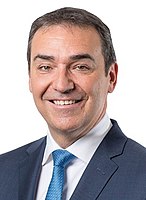| ||||||||||||||||||||||||||||||||||||||||||||||
All 47 seats in the South Australian House of Assembly 24 seats are needed for a majority 11 (of the 22) seats in the South Australian Legislative Council | ||||||||||||||||||||||||||||||||||||||||||||||
|---|---|---|---|---|---|---|---|---|---|---|---|---|---|---|---|---|---|---|---|---|---|---|---|---|---|---|---|---|---|---|---|---|---|---|---|---|---|---|---|---|---|---|---|---|---|---|
| Opinion polls | ||||||||||||||||||||||||||||||||||||||||||||||
| Registered | 1,266,719 | |||||||||||||||||||||||||||||||||||||||||||||
| Turnout | 1,127,642 (89%) ( | |||||||||||||||||||||||||||||||||||||||||||||
| ||||||||||||||||||||||||||||||||||||||||||||||
 Winning margin by electorate. | ||||||||||||||||||||||||||||||||||||||||||||||
| ||||||||||||||||||||||||||||||||||||||||||||||
The 2022 South Australian state election was held on 19 March 2022 to elect members to the 55th Parliament of South Australia. All 47 seats in the House of Assembly (the lower house, whose members were elected at the 2018 election), and half the seats in the Legislative Council (the upper house, last filled at the 2014 election) were up for re-election.
The one-term incumbent minority Liberal government, led by Premier Steven Marshall, was defeated in a landslide by the opposition Labor Party, led by Opposition Leader Peter Malinauskas. Marshall conceded to Malinauskas about three hours after the polls closed.[1] It is the first time since 1982, and only the fourth time since 1933, that a sitting government in South Australia has been defeated after a single term.
Labor won 27 seats in the lower house, while the Liberals retained 16 seats—with the remaining four seats won by independents.[2] The new ministry was sworn in two days after the election, and Malinauskas became the state's 47th Premier.[3]
In the 22-seat upper house where 11 seats were up for election, the result was five Labor, four Liberal, one Green, and one One Nation, for a total of nine Labor government seats, eight Liberal opposition seats, with five crossbenchers—two Green, two SA-Best, and one One Nation.[4] Consequently, the new Labor government would require an additional three non-government votes to pass legislation;[5] however, the Liberal upper house President was unexpectedly re-elected to the Presidency, which gave the Labor government nine of 21 seats during votes on the floor, meaning that only an additional two non-government votes are required to pass legislation.[6][7][8]
Like federal elections, South Australia has compulsory voting, uses full-preference instant-runoff voting for single-member electorates in the lower house, and optional preference single transferable voting in the proportionally represented upper house. The election was conducted by the Electoral Commission of South Australia (ECSA), an independent body answerable to Parliament.
- ^ Sarah Martin (19 March 2022). "South Australia election: Labor wins government as Liberal premier Steven Marshall concedes". The Guardian.
- ^ "South Australia Election 2022 Results". ABC News Elections.
- ^ Rebecca Opie (21 March 2022). "Peter Malinauskas sworn in as South Australia's new Premier alongside deputy and treasurer". ABC News.
- ^ Antony Green. "Legislative Council Results". ABC News Elections.
- ^ "South Australia gets first One Nation MP with Sarah Game elected to Legislative Council". ABC News. 27 April 2022.
- ^ "Drama in SA parliament as Liberal investigated by ICAC returned to top position". ABC News. 3 May 2022.
- ^ "'Beggars belief': Labor coup sidelines Libs, crossbench". 3 May 2022.
- ^ "SA 2022 – Legislative Council Result Finalised – Antony Green's Election Blog". 27 April 2022.

